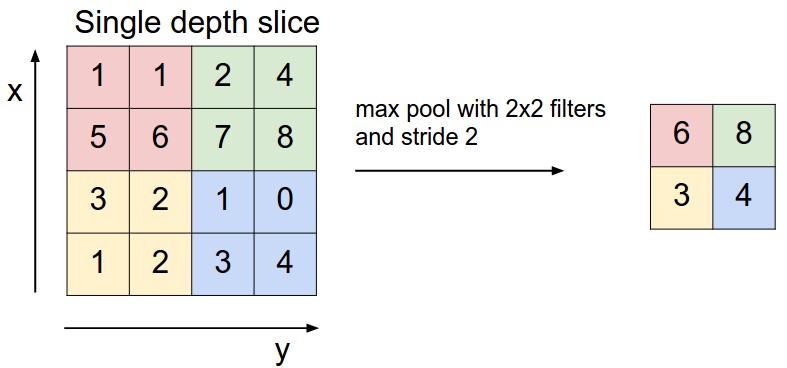17. Max Pooling Layers in Keras

Max pooling with 2x2 window and stride 2
Image source: http://cs231n.github.io/convolutional-networks/
Max Pooling Layers in Keras
To create a max pooling layer in Keras, you must first import the necessary module:
from keras.layers import MaxPooling2DThen, you can create a convolutional layer by using the following format:
MaxPooling2D(pool_size, strides, padding)Arguments
You must include the following argument:
pool_size- Number specifying the height and width of the pooling window.
There are some additional, optional arguments that you might like to tune:
strides- The vertical and horizontal stride. If you don't specify anything,strideswill default topool_size.padding- One of'valid'or'same'. If you don't specify anything,paddingis set to'valid'.
NOTE: It is possible to represent both pool_size and strides as either a number or a tuple.
You are also encouraged to read the official documentation.
Example
Say I'm constructing a CNN, and I'd like to reduce the dimensionality of a convolutional layer by following it with a max pooling layer. Say the convolutional layer has size (100, 100, 15), and I'd like the max pooling layer to have size (50, 50, 15). I can do this by using a 2x2 window in my max pooling layer, with a stride of 2, which could be constructed in the following line of code:
MaxPooling2D(pool_size=2, strides=2)If you'd instead like to use a stride of 1, but still keep the size of the window at 2x2, then you'd use:
MaxPooling2D(pool_size=2, strides=1)Checking the Dimensionality of Max Pooling Layers
Copy and paste the following code into a Python executable named pool-dims.py:
from keras.models import Sequential
from keras.layers import MaxPooling2D
model = Sequential()
model.add(MaxPooling2D(pool_size=2, strides=2, input_shape=(100, 100, 15)))
model.summary()Run python path/to/pool-dims.py and look at the output. It should appear as follows:

Feel free to change the arguments in your pool-dims.py file, and check how the shape of the max pooling layer changes.